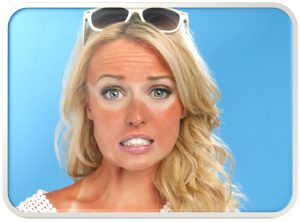Ultraviolet Radiation
- Sunlight has 2 types of harmful ultraviolet (UV) rays: UVA and UVB which both can lead to skin cancer
o UVA: prematurely ages skin causing wrinkles and age spots. It can also pass through window glass
o UVB: primary cause of sunburn. These rays are blocked by window glass.
- On a cloudy day, up to 80% of the UV rays from the sun can still pass through the clouds!
- There is no safe tan! Every time you tan, you damage your skin.
o The United States Department of Health & Human Services and the International Agency of Research on Cancer have declared UV radiation from the sun and artificial sources (i.e., tanning beds) as a known carcinogen.
How to Protect Your Skin
- Seek shade: remember the sun’s rays are strongest between 10 AM and 2 PM.
- Wear sun-protective clothing: long-sleeved shirts, pants, and wide-brimmed hats with sunglasses are recommended where possible while out in the sun.
- Generously apply sunscreen of an SPF of at least 30 or higher to exposed skin! Use “broad-spectrum” to provide protection from both UVA and UVB rays.
- Use caution near water, snow, and sand: The rays of sun are reflected on these surfaces and increase the chance of sunburn
- Avoid tanning beds: UV light from tanning can cause skin cancer and wrinkles! Try using self-tanning products and spray tans to achieve a tan look if desired.
- Also, be sure to have your skin regularly checked by a dermatologist, especially if any spots are changing or growing!
Sunscreen: What to Look For
- The best sunscreen is one you will use over and over again! The kind of sunscreens elected is a matter of personal choice and may vary depending on the area of body being protected.
o Creams are the best for dry skin and the face. Gels are good for area areas including the scalp or male chest. Sticks are useful around the eyes.
o Sprays are preferred by some patients for ease of application, especially for children. Make sure to use enough to cover the entire surface thoroughly.
o Sunscreens for sensitive skin and for babies are also available.
- If using cosmetics with sunscreen in combination, be sure to reapply to achieve the best sun protection.
- Be sure to check out our new Elta MD sunscreens in Ada!
How to Use Sunscreen
- One ounce of sunscreen (enough to fill a shot glass) is the amount of sunscreen needed to cover the exposed areas of the body.
- Apply sunscreen to dry skin at least 15 minutes prior to going outdoors.
- Do not forget to protect your lips! Apply a lip balm or lipstick with an SPF of 30 or higher.
- Re-apply sunscreen every 2 hours or after swimming or sweating heavily.
Sun-Protective Clothing
- Sun-protective clothing is specifically designed for sun protection. It is fabric rated for its level of UV protection or fabric can be pre-treated with UV inhibiting ingredients.
- Some UV-blocking textiles and clothing are designed with ventilated weaves and moisture wicking which assist in cooling and breathability of clothing. Therefore, it can be easily tolerated in warm and humid temperatures!
- Coolibar and other companies such as Columbia offer many excellent options to keep you safe in the sun!
- Ada Aesthetics also sells fashionable hats to protect the face, ears, and neck!
Vitamin D and UV Exposure
- The American Academy of Dermatology does not recommend getting vitamin D from sun exposure or indoor tanning because the UV rays can cause skin cancer.
o Getting vitamin D from a healthy diet that includes foods naturally with vitamin D, foods or beverages fortified with vitamin D, and vitamin D supplements for a healthier alternative.
- To protect against UV-induced skin cancer, follow the recommendations on how to protect your skin from the sun in the section above. If concerned about vitamin D deficiency, discuss options with your doctor.

Indoor Tanning
- Indoor tanning can raise your risk of melanoma by at least 59%, and risk increases with each use. Melanoma is the deadliest form of skin cancer.
- Melanoma is increasing faster in young women (15-29 years old) than in young men of the same age, and nearly 70% of tanning salon patrons are Caucasian girls and young women.
- Evidence from several studies has shown that exposure to UV radiation room indoor tanning devices is associated with increased risk of both melanoma and non-melanoma skin cancers, such as squamous and basal cell carcinomas.
- Indoor tanning equipment emits UVA and UVB radiation. The amount of radiation produced is similar to the sun and in some cases is even stronger.
- Studies have demonstrated that UV radiation from tanning beds damage the DNA in skin cells. Excessive exposure to UV radiation can lead to premature skin aging, immune suppression, and even eye damage like cataracts and ocular melanoma.
- Due to the increased risk from tanning beds, seven states (Washington, Illinois, Nevada, Texas, Oregon, Vermont, and California) have banned indoor tanning for minors under the age of 18.
- Avoid indoor tanning! Use self-tanning products and spray tans to achieve a tan look if desired!




